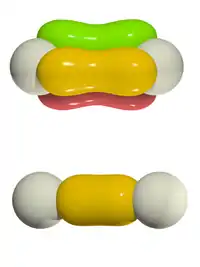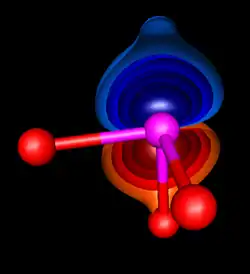Wannier function
The Wannier functions are a complete set of orthogonal functions used in solid-state physics. They were introduced by Gregory Wannier.[1][2] Wannier functions are the localized molecular orbitals of crystalline systems.

The Wannier functions for different lattice sites in a crystal are orthogonal, allowing a convenient basis for the expansion of electron states in certain regimes. Wannier functions have found widespread use, for example, in the analysis of binding forces acting on electrons; the existence of exponentially localized Wannier functions in insulators has been proved in 2006.[3] Specifically, these functions are also used in the analysis of excitons and condensed Rydberg matter.
Definition

Although, like localized molecular orbitals, Wannier functions can be chosen in many different ways,[4] the original,[1] simplest, and most common definition in solid-state physics is as follows. Choose a single band in a perfect crystal, and denote its Bloch states by
where uk(r) has the same periodicity as the crystal. Then the Wannier functions are defined by
- ,
where
- R is any lattice vector (i.e., there is one Wannier function for each Bravais lattice vector);
- N is the number of primitive cells in the crystal;
- The sum on k includes all the values of k in the Brillouin zone (or any other primitive cell of the reciprocal lattice) that are consistent with periodic boundary conditions on the crystal. This includes N different values of k, spread out uniformly through the Brillouin zone. Since N is usually very large, the sum can be written as an integral according to the replacement rule:
where "BZ" denotes the Brillouin zone, which has volume Ω.
Properties
On the basis of this definition, the following properties can be proven to hold:[5]
- For any lattice vector R' ,
In other words, a Wannier function only depends on the quantity (r − R). As a result, these functions are often written in the alternative notation
- The Bloch functions can be written in terms of Wannier functions as follows:
- ,
where the sum is over each lattice vector R in the crystal.
- The set of wavefunctions is an orthonormal basis for the band in question.
Wannier functions have been extended to nearly periodic potentials as well.[6]
Localization
The Bloch states ψk(r) are defined as the eigenfunctions of a particular Hamiltonian, and are therefore defined only up to an overall phase. By applying a phase transformation eiθ(k) to the functions ψk(r), for any (real) function θ(k), one arrives at an equally valid choice. While the change has no consequences for the properties of the Bloch states, the corresponding Wannier functions are significantly changed by this transformation.
One therefore uses the freedom to choose the phases of the Bloch states in order to give the most convenient set of Wannier functions. In practice, this is usually the maximally-localized set, in which the Wannier function ϕR is localized around the point R and rapidly goes to zero away from R. For the one-dimensional case, it has been proved by Kohn[7] that there is always a unique choice that gives these properties (subject to certain symmetries). This consequently applies to any separable potential in higher dimensions; the general conditions are not established, and are the subject of ongoing research.[3]
A Pipek-Mezey style localization scheme has also been recently proposed for obtaining Wannier functions.[8] Contrary to the maximally localized Wannier functions (which are an application of the Foster-Boys scheme to crystalline systems), the Pipek-Mezey Wannier functions do not mix σ and π orbitals.
Modern theory of polarization
Wannier functions have recently found application in describing the polarization in crystals, for example, ferroelectrics. The modern theory of polarization is pioneered by Raffaele Resta and David Vanderbilt. See for example, Berghold,[9] and Nakhmanson,[10] and a power-point introduction by Vanderbilt.[11] The polarization per unit cell in a solid can be defined as the dipole moment of the Wannier charge density:
where the summation is over the occupied bands, and Wn is the Wannier function localized in the cell for band n. The change in polarization during a continuous physical process is the time derivative of the polarization and also can be formulated in terms of the Berry phase of the occupied Bloch states.[5][12]
Wannier interpolation
Wannier functions are often used to interpolate bandstructure calculated ab initio on coarse grip of k-points to any arbitrary k-point. This is particularly useful for evaluation Brillouin-zone integrals on dense grids and searching of Weyl points, and also taking derivatives in the k-space. This approach is similar in spirit to tight binding approximation, but in contrast allows for an exact description of bands in a certain energy range. Wannier interpolation schemes have been derived for spectral properties,[13] anomalous Hall conductivity,[14] orbital magnetization,[15] thermoelectric and electronic transport properties,[16] gyrotropic effects,[17] shift current,[18] spin Hall conductivity [19] [20] and other effects.
See also
References
- Wannier Gregory H (1937). "The Structure of Electronic Excitation Levels in Insulating Crystals". Physical Review. 52 (3): 191–197. Bibcode:1937PhRv...52..191W. doi:10.1103/PhysRev.52.191.
- Wannier, Gregory H. (1 September 1962). "Dynamics of Band Electrons in Electric and Magnetic Fields". Reviews of Modern Physics. American Physical Society (APS). 34 (4): 645–655. Bibcode:1962RvMP...34..645W. doi:10.1103/revmodphys.34.645. ISSN 0034-6861.
- Brouder, Christian; Panati, Gianluca; Calandra, Matteo; Mourougane, Christophe; Marzari, Nicola (25 January 2007). "Exponential Localization of Wannier Functions in Insulators". Physical Review Letters. American Physical Society (APS). 98 (4): 046402. arXiv:cond-mat/0606726. doi:10.1103/physrevlett.98.046402. ISSN 0031-9007.
- Marzari et al.: An Introduction to Maximally-Localized Wannier Functions
- A Bohm, A Mostafazadeh, H Koizumi, Q Niu and J Zqanziger (2003). The Geometric Phase in Quantum Systems (Submitted manuscript). Springer. pp. §12.5, p. 292 ff. doi:10.1007/978-3-662-10333-3. ISBN 978-3-540-00031-0.CS1 maint: multiple names: authors list (link)
- MP Geller and W Kohn Theory of generalized Wannier functions for nearly periodic potentials Physical Review B 48, 1993
- W. Kohn (1959). "Analytic Properties of Bloch Waves and Wannier Functions". Physical Review. 115 (4): 809–821. Bibcode:1959PhRv..115..809K. doi:10.1103/PhysRev.115.809.
- Jónsson Elvar Ö., Lehtola Susi, Puska Martti, Jónsson Hannes (2017). "Theory and Applications of Generalized Pipek–Mezey Wannier Functions". Journal of Chemical Theory and Computation. 13 (2): 460–474. arXiv:1608.06396. doi:10.1021/acs.jctc.6b00809. PMID 28099002.CS1 maint: multiple names: authors list (link)
- Berghold, Gerd; Mundy, Christopher J.; Romero, Aldo H.; Hutter, Jürg; Parrinello, Michele (15 April 2000). "General and efficient algorithms for obtaining maximally localized Wannier functions". Physical Review B. American Physical Society (APS). 61 (15): 10040–10048. doi:10.1103/physrevb.61.10040. ISSN 0163-1829.
- Nakhmanson, S. M.; Calzolari, A.; Meunier, V.; Bernholc, J.; Buongiorno Nardelli, M. (10 June 2003). "Spontaneous polarization and piezoelectricity in boron nitride nanotubes". Physical Review B. American Physical Society (APS). 67 (23): 235406. arXiv:cond-mat/0305329v1. doi:10.1103/physrevb.67.235406. ISSN 0163-1829.
- D Vanderbilt Berry phases and Curvatures in Electronic Structure Theory.
- C. Pisani (1994). Quantum-mechanical Ab-initio Calculation of the Properties of Crystalline Materials (Proceedings of the IV School of Computational Chemistry of the Italian Chemical Society ed.). Springer. p. 282. ISBN 978-3-540-61645-0.
- Yates, Jonathan R.; Wang, Xinjie; Vanderbilt, David; Souza, Ivo (2007-05-21). "Spectral and Fermi surface properties from Wannier interpolation". Physical Review B. American Physical Society (APS). 75 (19). arXiv:cond-mat/0702554. doi:10.1103/physrevb.75.195121. ISSN 1098-0121.
- Wang, Xinjie; Yates, Jonathan R.; Souza, Ivo; Vanderbilt, David (2006-11-21). "Ab initiocalculation of the anomalous Hall conductivity by Wannier interpolation". Physical Review B. American Physical Society (APS). 74 (19). arXiv:cond-mat/0608257. doi:10.1103/physrevb.74.195118. ISSN 1098-0121.
- Lopez, M. G.; Vanderbilt, David; Thonhauser, T.; Souza, Ivo (2012-01-31). "Wannier-based calculation of the orbital magnetization in crystals". Physical Review B. American Physical Society (APS). 85 (1). arXiv:1112.1938. doi:10.1103/physrevb.85.014435. ISSN 1098-0121.
- "BoltzWann: A code for the evaluation of thermoelectric and electronic transport properties with a maximally-localized Wannier functions basis". Computer Physics Communications. 185 (1): 422–429. 2014-01-01. arXiv:1305.1587. doi:10.1016/j.cpc.2013.09.015. ISSN 0010-4655. Retrieved 2020-07-13.
- Tsirkin, Stepan S.; Puente, Pablo Aguado; Souza, Ivo (2018-01-29). "Gyrotropic effects in trigonal tellurium studied from first principles". Physical Review B. American Physical Society (APS). 97 (3). arXiv:1710.03204. doi:10.1103/physrevb.97.035158. ISSN 2469-9950.
- Ibañez-Azpiroz, Julen; Tsirkin, Stepan S.; Souza, Ivo (2018-06-26). "Ab initio calculation of the shift photocurrent by Wannier interpolation". Physical Review B. American Physical Society (APS). 97 (24). arXiv:1804.04030. doi:10.1103/physrevb.97.245143. ISSN 2469-9950.
- Qiao, Junfeng; Zhou, Jiaqi; Yuan, Zhe; Zhao, Weisheng (2018-12-03). "Calculation of intrinsic spin Hall conductivity by Wannier interpolation". Physical Review B. American Physical Society (APS). 98 (21). arXiv:1810.07637. doi:10.1103/physrevb.98.214402. ISSN 2469-9950.
- Ryoo, Ji Hoon; Park, Cheol-Hwan; Souza, Ivo (2019-06-07). "Computation of intrinsic spin Hall conductivities from first principles using maximally localized Wannier functions". Physical Review B. American Physical Society (APS). 99 (23). arXiv:1906.07139. doi:10.1103/physrevb.99.235113. ISSN 2469-9950.
Further reading
- Karin M Rabe; Jean-Marc Triscone; Charles H Ahn (2007). Physics of Ferroelectrics: a Modern Perspective. Springer. p. 2. ISBN 978-3-540-34590-9.
External links
- Wannier Gregory H (1937). "The Structure of Electronic Excitation Levels in Insulating Crystals". Physical Review. 52 (3): 191–197. Bibcode:1937PhRv...52..191W. doi:10.1103/PhysRev.52.191.
- Wannier90 computer code that calculates maximally localized Wannier functions
- Wannier Transport code that calculates maximally localized Wannier functions fit for Quantum Transport applications
- WannierTools: An open-source software package for novel topological materials
- WannierBerri - a python code for Wannier interpolation and tight-binding calculations